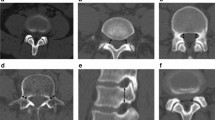Abstract
Objective
The objective was to demonstrate the feasibility of MRI/CT fusion in demonstrating lumbar nerve root compromise.
Materials and methods
We combined 3-dimensional (3-D) computed tomography (CT) imaging of bone with 3-D magnetic resonance imaging (MRI) of neural architecture (cauda equina and nerve roots) for two patients using VirtualPlace software.
Results
Although the pathological condition of nerve roots could not be assessed using MRI, myelography or CT myelography, 3-D MRI/CT fusion imaging enabled unambiguous, 3-D confirmation of the pathological state and courses of nerve roots, both inside and outside the foraminal arch, as well as thickening of the ligamentum flavum and the locations, forms and numbers of dorsal root ganglia. Positional relationships between intervertebral discs or bony spurs and nerve roots could also be depicted.
Conclusion
Use of 3-D MRI/CT fusion imaging for the lumbar vertebral region successfully revealed the relationship between bone construction (bones, intervertebral joints, and intervertebral disks) and neural architecture (cauda equina and nerve roots) on a single film, three-dimensionally and in color. Such images may be useful in elucidating complex neurological conditions such as degenerative lumbar scoliosis(DLS), as well as in diagnosis and the planning of minimally invasive surgery.


Similar content being viewed by others
References
Kikuchi S, Hasue M. Radicular symptoms of lumbo-sacral spine: anatomic consideration. Tokyo: Kanehira; 1996.
Matsumoto M, Chiba K, Ishii K, et al. Surgical result for posterior decompression for extra foraminal stenosis associated with osteophytes of L5-S1 vertebral bodies (in Japanese). Rinsyou Seikei Geka. 2007;40(7):799–803.
Ando M, Tamaki T, Yoshida M. Diagnosis for lumbar foraminal stenosis using sensory nerve action potential (in Japanese). Orthop Surg Traumatol. 2008;51:299–307.
Macnab I. Negative disc explosion; an analysis of causes of nerve root involvement in sixty-eight patients. J Bone Joint Surg Am. 1971;53-A:891–903.
Burton CV, Kirkaldy-Willis WH, et al. Causes of failure of surgery on the lumbar spine. Clin Orthop Relat Res. 1981;157:191–9.
Yamada H, Yoshida M, Kido Y, et al. 3D-MR imaging of nerve root (in Japanese). Spine Spinal Cord. 2008;21(2):115–21.
Kamogawa J, Katagi R, Kodama K. The 3D-MRI/MRA/CT fusion imaging in spine and spinal cord disorders focusing on upper cervical spine: two cases reports (in Japanese). Spine Spinal Cord. 2009 (in press).
Ray CD. Extensive lumbar decompression: patient selection and results. In: White AH, Rothman RH, Ray CD, et al. (eds). Lumbar spine surgery. St Louis: Mosby; 1986. p. 164–74.
Kawai M, Yoshida M. For safety improvement of microendoscopic discectomy. The J Japan Soc Spine Surg Related Res (in Japanese). 2007;18(4):770–8.
Author information
Authors and Affiliations
Corresponding author
Rights and permissions
About this article
Cite this article
Yamanaka, Y., Kamogawa, J., Katagi, R. et al. 3-D MRI/CT fusion imaging of the lumbar spine. Skeletal Radiol 39, 285–288 (2010). https://doi.org/10.1007/s00256-009-0788-5
Received:
Revised:
Accepted:
Published:
Issue Date:
DOI: https://doi.org/10.1007/s00256-009-0788-5




